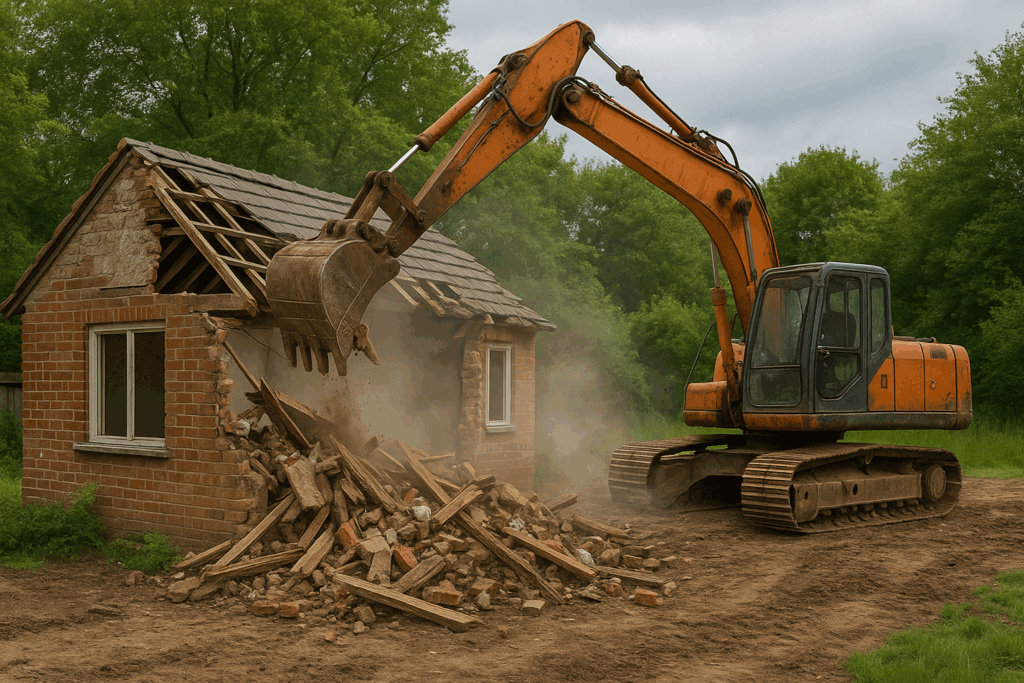Prior Approval for Demolition of Buildings
Class B of Part 11 of the GPDO allows for the demolition of buildings under permitted development. In certain circumstances this is subject to Prior Approval.
Please see all the details about Class B on this page. You can also check our handy flowchart to see if your demolition qualifies for prior approval, or whether you can just go ahead.
Unlike other prior approvals this is a 28 day process. You apply to the local authority and pay the required fee. Check out this page for all planning fees within England. As of April 2025 the fee for Class B is £240. Note that the Planning Portal, which is a private company will add an additional fee of £84 to process your credit card and forward the application to the local authority. So you might wish to submit directly. The email address for all local authorities can be found here,
Once submitted the local authority should confirm whether prior approval is or is not required and you can go ahead. They are only allowed 28 days following submission of the application form and payment of the fee. If they have not responded within 28 days you may go ahead as long as your demolition complies with Class B – if it doesn’t you might have issues.
Importantly Class B does not apply to parts of a building. This could well be an alteration rather than a demolition.
The building will be greater than 50 cubic metres but less than 115 cubic metres if in a conservation area – it can be larger outside of a conservation area. Again check our handy flowchart to see if your demolition qualifies for prior approval under Class B.

What information is required in the prior approval for demolition?
Whilst this list below looks extensive, it is fairly straight forward. The following information is required:-
- Site location. The Easting and Northing must be provided if you do not have a postcode for the site. The local authority needs to know where it is.
- Applicant details
- Agent details if applicable
- Description of the buildings to be demolished
- Reasons why the demolition needs to take place
- Proposed demolition method (maybe as per demotion company?)
- Disposal method of the rubble after demolition (maybe as per demotion company?)
- Details of the proposed restoration of the site – maybe simply levelling of the surface?
- Date when you expect the works to commence (date must be post application submission)
- Date when you expect the works to be completed (date must be post application submission)
- If there are any public Rights of Way within the site or immediately adjoining the site
- Whether you intend to rebuild the demolished building in the future
- Whether any trees need to be pruned or felled to allow the demolition
- Whether the site can be seen from the public highway
- Who the LPA should contact should a site visit be required
- Whether you made an optional pre-application application prior to this application
- A signed declaration
- A site notice will need to be displayed for at least 21 days
- Finally a site location plan is also required
Although whilst all these items appear on the application form, they are not all required fields. But they do help the local authority determine if a prior approval is not required.
The legislation for Class B is repeated below. B.2(b) is the relevant information.
Legislation
Class B – demolition of buildings
Permitted development
B. Any building operation consisting of the demolition of a building.
Development not permitted
B.1 Development is not permitted by Class B if—
(a) the building has been rendered unsafe or otherwise uninhabitable by the action or inaction of any person having an interest in the land on which the building stands and it is practicable to secure safety or health by works of repair or works for affording temporary support;
(b) the demolition is “relevant demolition” for the purposes of section 196D of the Act (demolition of an unlisted etc building in a conservation area)
(c) the building is used, or was last used, for a purpose falling within—
(i) article 3(6)(p) (drinking establishments etc.) of the Use Classes Order; or
(ii) article 3(6)(q) (drinking establishments with expanded food provision) of that Order;
(d) the building is used, or was last used, for the purpose of—
(i) a concert hall;
(ii) a venue for live music performance; or
(iii) a theatre; or
(e) the demolition relates to a statue, memorial or monument (“a commemorative structure”) in place for a period of at least 10 years on the date of any proposed demolition, other than a commemorative structure—
(i) that is a listed building;
(ii) that is a scheduled monument;
(iii) within a cemetery, on consecrated land, or within the curtilage of a place of public worship;
(iv) within the grounds of a museum or art gallery; or
(v) within the curtilage of a dwellinghouse.
Conditions
B.2 Development is permitted by Class B subject to the following conditions—
(a) where demolition is urgently necessary in the interests of safety or health and the measures immediately necessary in such interests are the demolition of the building the developer must, as soon as reasonably practicable, give the local planning authority a written justification of the demolition;
(b) where the demolition does not fall within paragraph (a) and is not excluded demolition—
(i) the developer must, before beginning the development, apply to the local planning authority for a determination as to whether the prior approval of the authority will be required as to the method of demolition and any proposed restoration of the site;
(ii) an application described in paragraph (b)(i) must be accompanied by a written description of the proposed development, a statement that a notice has been posted in accordance with paragraph (b)(iv) and any fee required to be paid;
(iv) subject to paragraph (b)(v), the applicant must display a site notice by site display on or near the land on which the building to be demolished is sited and must leave the notice in place for not less than 21 days in the period of 28 days beginning with the date on which the application was submitted to the local planning authority;
(v) where the site notice is, without any fault or intention of the applicant, removed, obscured or defaced before the period of 21 days referred to in paragraph (b)(iv) has elapsed, the applicant is treated as having complied with the requirements of that paragraph if the applicant has taken reasonable steps for protection of the notice and, if need be, its replacement;
(vii) the development must not begin before the occurrence of one of the following—
(aa) the receipt by the applicant from the local planning authority of a written notice of their determination that such prior approval is not required;
(bb) where the local planning authority give the applicant notice within 28 days following the date of receiving the application of their determination that such prior approval is required, the giving of such approval; or
(cc) the expiry of 28 days following the date on which the application was received by the local planning authority without the local planning authority making any determination as to whether such approval is required or notifying the applicant of their determination;
(viii) the development must, except to the extent that the local planning authority otherwise agree in writing, be carried out—
(aa) where prior approval is required, in accordance with the details approved;
(bb) where prior approval is not required, in accordance with the details submitted with the application;
(ix) the development must be carried out—
(aa) where approval has been given by the local planning authority, within a period of 5 years from the date on which approval was given;
(bb) in any other case, within a period of 5 years from the date on which the local planning authority were given the information referred to in paragraph (b)(ii).
Interpretation of Class B
B.3 For the purposes of Class B—
“cemetery” has the meaning given by section 214(8) of the Local Government Act 1972113;
“dwellinghouse” does not include educational accommodation;
“excluded demolition” means demolition—
(a) on land which is the subject of a planning permission, for the redevelopment of the land, granted on an application or deemed to be granted under Part 3 of the Act (control over development),
(b) permitted to be carried out by a consent under Part 1 of the Ancient Monuments and Archaeological Areas Act 1979 (scheduled monument consent),
(c) permitted to be carried out by a consent under Part 1 of the Planning (Listed Buildings and Conservation Areas) Act 1990 (listed building consent),
(d) required or permitted to be carried out by or under any other enactment, or
(e) required to be carried out by virtue of a relevant obligation;
“relevant obligation” means—
(a) an obligation arising under an agreement made under section 106 of the Act, as originally enacted (agreements regulating development or use of land);
(b) a planning obligation entered into under section 106 of the Act, as substituted by section 12 of the Planning and Compensation Act 1991 (planning obligations), or under section 299A of the Act (Crown planning obligations);
(c) an obligation arising under, or under an agreement made under, any provision corresponding to section 106 of the Act, as originally enacted or as substituted by the Planning and Compensation Act 1991, or to section 299A of the Act;
“site notice” means a notice containing—
(a) the name of the applicant,
(b) a description, including the address, of the building or buildings which it is proposed to be demolished,
(c) a statement that the applicant has applied to the local planning authority for a determination as to whether the prior approval of the authority will be required as to the method of demolition and any proposed restoration of the site,
(d) the date on which the applicant proposes to carry out the demolition, and
(e) the name and address of the local planning authority,
and which is signed and dated by or on behalf of the applicant;
Demolition of buildings Page Updated: 19th May 2025



